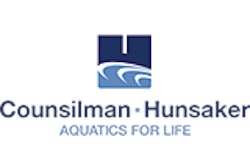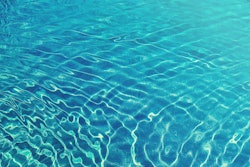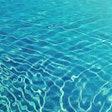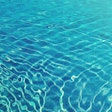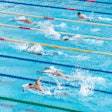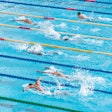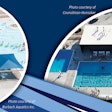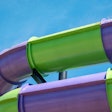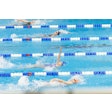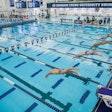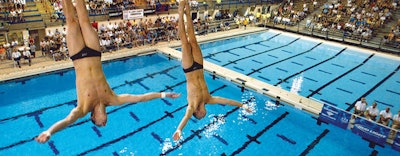
The design of a world-class diving venue requires understanding diving facility guidelines, diving competition rules, and the intricate interactions between divers and their environment.
First and foremost, a dive facility must meet the minimum standards of the competition taking place. For example, the overhead clearance above the diving boards and platforms must be at least that specified in the NFHS, NCAA, USA Swimming & Diving, and FINA diving regulations. This is typically five meters (16 feet, 5 inches) above the highest diving board or platform and is in place so that divers do not hit the ceiling structure. This is just one of numerous design considerations for an elite diving venue.
So, what additional attributes make a world-class diving facility? Here's a top-10 list:
1. SEPARATE DIVE POOL
While not a requirement, a separate dive pool is desired for elite dive competition and training. This allows for swimming and diving training to take place simultaneously, as well as accommodate world-class diving events.
Moreover, a separate dive pool can be kept at a warmer temperature than the traditional competition pool — typically between 85 and 86 degrees compared to a competition pool's 78-to-82-degree range. Divers are in the water for only a few seconds, and a warmer water temperature is much more comfortable, while the cooler temperature in competition pools is ideal for highly aerobic training and competitive swimming.
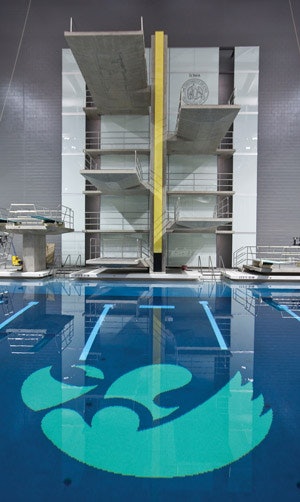 University of Iowa diving platforms (PHOTO BY STEPHEN MALLY PHOTOGRAPHY)
University of Iowa diving platforms (PHOTO BY STEPHEN MALLY PHOTOGRAPHY)
2. 10-METER PLATFORM TOWER AND SPRINGBOARDS
There are two kinds of diving competition: springboard and platform. Springboard competition takes place at 1-meter and 3-meter heights. At elite venues, a minimum of two 1-meter and two 3-meter springboards are provided. These competition springboards are typically placed on the same side of the pool as the platforms. Often, additional springboards are placed around the dive pool for practice and summer camps.
Platform diving competition takes place at 10 meters, though 1-, 3-, 5-, and 7.5-meter heights are also typically provided for training and warm-ups. Occasionally, a meter platform is constructed for divers to practice takeoffs. A facility without a 10-meter platform can host a platform diving event on a 5-meter tower if both teams agree on this height.
There are two configurations for a platform tower: a two-centerline tower or a three-centerline tower. A two-centerline tower has the 10-meter platform over the 5-meter and 1-meter platforms, and the 7.5-meter platform over the 3-meter platform. A three-centerline tower has the 10-meter tower alone in the center with the other platforms on each side. A three-centerline tower is safer, as there are fewer possibilities for collision during training and competition. It also has a wider footprint. That said, two-centerline towers have been used successfully at numerous world-class facilities.
3. DARK-COLORED BOTTOM
When divers flip and rotate, they can lose their bearings without a color contrast between the pool water and the natatorium ceiling or sky. It is recommended by USA Diving that the bottom of the dive pool be a dark color — typically dark blue or black — and the walls white.
There may be issues with local health departments, as most codes require a white bottom so that a lifeguard can detect a person lying on the bottom. Most health departments will grant a variance on this regulation if the dive pool is used only for dive training and competition and is classified as a special-use pool.
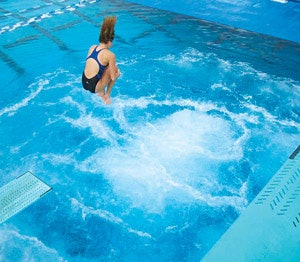
4. SPARGERS AND WATER-SURFACE AGITATORS
Spargers (air-bubbling systems) are utilized for diving practice. This piece of equipment releases air directly underneath the path of the divers' travel to soften their impact with the surface of the water. It is especially useful when divers are practicing new dives.
Water-surface agitators are used during competition to break up the reflection of the ceiling or sky. Agitators are installed under all platforms and springboards. Water is typically fed to the agitator by the recirculation pump. A remote on/off switch should be provided on the pool deck or in the pool office for convenient operation of the water-surface agitator pump.

5. SPA AND/OR SHOWERS
A desired feature at all major diving facilities, a spa allows divers to relax their muscles before or after dives. The spa should be able to accommodate at least eight divers with water temperatures between 102 and 104 degrees.
Showers are also a desired feature, located underneath the dive tower or along the back wall. Sometimes only showers are provided, but both showers and a spa are desired features.
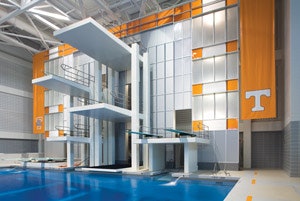 TENNESSEE PRIDE The University of Tennessee’s Allan Jones Intercollegiate Aquatic Center is capable of hosting Southeastern Conference and NCAA Championships, as well as international events. (Photo Courtesy of Counsilman-Hunsaker)
TENNESSEE PRIDE The University of Tennessee’s Allan Jones Intercollegiate Aquatic Center is capable of hosting Southeastern Conference and NCAA Championships, as well as international events. (Photo Courtesy of Counsilman-Hunsaker)
6. LARGE STAIR SYSTEM
All world-class diving pools have a large stair system for easy egress out of the pool after a dive. The stair system typically extends down four feet below the water surface. Stair systems can be located directly below the 10-meter platform in a three-centerline configuration or have multiple locations if a two-centerline tower is utilized. Typically, a recessed toe ledge is located four feet below the water surface on all four sides of the dive pool, providing the diver a resting spot within the water while receiving instruction.
7. DIVING HARNESS/SPOTTING RIG
Diving coaches like to utilize a diving harness and spotting rig for training in the dive pool. In elite facilities, there may be two diving harnesses and spotting rigs — mounted over one springboard and one platform. This allows divers to attempt new dives without the risk of injury and full impact with the water surface, since a spotter can hold them in the air.
For each harness, a single pulley and a double pulley should be utilized. The double pulley should be positioned directly overhead of the dive coach/spotter. This position should be a minimum of three feet from the pool edge, to prevent the spotter from being pulled into the water.
8. DRY-LAND TRAINING ROOM
For high-level diving, a separate dry-land training room should be provided and equipped with dry-land springboards and pits, a trampoline and digital video recording capability. Recording equipment should be available in the dry-land training area, as well as on deck near the springboards and platforms. Often, dry-land training rooms are small, necessitating recording equipment components be located on the pool deck next to the dive tower.
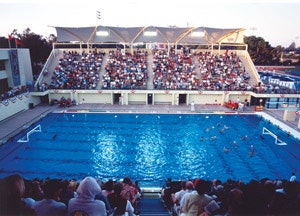 Stanford U spectaor seating (Photo Courtesy of Counsilman-Hunsaker)
Stanford U spectaor seating (Photo Courtesy of Counsilman-Hunsaker)
9. SPECTATOR SEATING AND JUDGE VIEWING
The best angle for spectators to view a diving competition is from the side. It is also advantageous to be elevated in a mezzanine. Some meets are held using only temporary seating, while large world-class diving events have recently been staged with temporary pools in front of 10,000 or more seats.
Due to the deck and spectator seating requirements for a championship facility, the square footage — and cost — of such facilities is greatly increased. Ample deck space on the sides of the dive pool is needed to accommodate judges viewing the dives. Three, five, seven, nine or 11 judges may be positioned on the sides of the pool deck depending on the level of competition.
 SKY DIVES In 2001, Stanford University’s highly acclaimed aquatics program saw construction of a state-of-the-art facility that includes a 4,600-square-foot outdoor diving pool with a three-centerline tower and four springboards. (Photo Courtesy of Counsilman-Hunsaker)
SKY DIVES In 2001, Stanford University’s highly acclaimed aquatics program saw construction of a state-of-the-art facility that includes a 4,600-square-foot outdoor diving pool with a three-centerline tower and four springboards. (Photo Courtesy of Counsilman-Hunsaker)
10. LIGHTING AND TV CONSIDERATIONS
Lighting affects safety, aesthetics and spectator viewing, and therefore is a significant design issue. Aquatic facilities present unique considerations for both artificial lighting and fenestration, and standards affecting the lighting of dive pools and competitions are set by sport sanctioning bodies. During major competitions, lighting levels should be close to 200 foot-candles. Practice lighting can be less, but still needs to be in the 75-to-100-foot-candle range.
Light deteriorates rapidly underwater as depth increases. Field tests show that approximately 50 percent of light at the water surface is lost within the first 12 inches. In deep-water dive pools, underwater lights may be necessary to increase illumination under the water surface, and are often required in outdoor pools. Underwater lights can also be helpful in reducing glare by "bleaching out" surface reflection.
Major sports networks will bring in lighting to achieve the 200-foot-candle level if the facility is not constructed with the capability to meet that lighting level. Care needs to be taken in positioning. Lighting cannot shine directly in the face of a diver, as it will be a distraction during the dive.
Television requirements also include camera tracks to follow the diver from takeoff to underwater — the camera essentially falls with the diver. Camera platforms are also needed at various elevations and positions to provide the television audience with multiple angles. These are located in the spectator seating area, on deck and sometimes within the roof structure.
RELATED: Giving Aquatic Competition Venues the Star Treatment
Doug Cook is chairman of the board at Counsilman-Hunsaker, an international aquatic consulting firm with offices in St. Louis, Denver, Los Angeles and Dallas. This article originally appeared in the December 2014 issue of Athletic Business with the title "Spring Loaded."


















